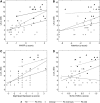Use of Questionnaire-Based Measures in the Assessment of Listening Difficulties in School-Aged Children
- PMID: 26002277
- PMCID: PMC4617294
- DOI: 10.1097/AUD.0000000000000180
Use of Questionnaire-Based Measures in the Assessment of Listening Difficulties in School-Aged Children
Abstract
Objectives: In this study, the authors assessed the potential utility of a recently developed questionnaire (Evaluation of Children's Listening and Processing Skills [ECLiPS]) for supporting the clinical assessment of children referred for auditory processing disorder (APD).
Design: A total of 49 children (35 referred for APD assessment and 14 from mainstream schools) were assessed for auditory processing (AP) abilities, cognitive abilities, and symptoms of listening difficulty. Four questionnaires were used to capture the symptoms of listening difficulty from the perspective of parents (ECLiPS and Fisher's auditory problem checklist), teachers (Teacher's Evaluation of Auditory Performance), and children, that is, self-report (Listening Inventory for Education). Correlation analyses tested for convergence between the questionnaires and both cognitive and AP measures. Discriminant analyses were performed to determine the best combination of tests for discriminating between typically developing children and children referred for APD.
Results: All questionnaires were sensitive to the presence of difficulty, that is, children referred for assessment had significantly more symptoms of listening difficulty than typically developing children. There was, however, no evidence of more listening difficulty in children meeting the diagnostic criteria for APD. Some AP tests were significantly correlated with ECLiPS factors measuring related abilities providing evidence for construct validity. All questionnaires correlated to a greater or lesser extent with the cognitive measures in the study. Discriminant analysis suggested that the best discrimination between groups was achieved using a combination of ECLiPS factors, together with nonverbal Intelligence Quotient (cognitive) and AP measures (i.e., dichotic digits test and frequency pattern test).
Conclusions: The ECLiPS was particularly sensitive to cognitive difficulties, an important aspect of many children referred for APD, as well as correlating with some AP measures. It can potentially support the preliminary assessment of children referred for APD.
Conflict of interest statement
The authors declare no other conflict of interest.
Figures





Similar articles
-
What Can We Learn about Auditory Processing from Adult Hearing Questionnaires?J Am Acad Audiol. 2015 Nov-Dec;26(10):824-37. doi: 10.3766/jaaa.15009. J Am Acad Audiol. 2015. PMID: 26554488
-
A Multi-Sample Comparison and Rasch Analysis of the Evaluation of Children's Listening and Processing Skills Questionnaire.Ear Hear. 2024 Sep-Oct 01;45(5):1202-1215. doi: 10.1097/AUD.0000000000001509. Epub 2024 Jun 3. Ear Hear. 2024. PMID: 38825739 Free PMC article.
-
Measuring Perceptions of Classroom Listening in Typically Developing Children and Children with Auditory Difficulties Using the LIFE-UK Questionnaire.J Am Acad Audiol. 2018 Jul/Aug;29(7):656-667. doi: 10.3766/jaaa.17053. J Am Acad Audiol. 2018. PMID: 29988013
-
Quality of questionnaires for the assessment of otitis media with effusion in children.Clin Otolaryngol. 2018 Apr;43(2):572-583. doi: 10.1111/coa.13026. Epub 2017 Dec 4. Clin Otolaryngol. 2018. PMID: 29106777
-
Sources of pathology underlying listening disorders in children.Int J Psychophysiol. 2015 Feb;95(2):125-34. doi: 10.1016/j.ijpsycho.2014.07.006. Epub 2014 Jul 31. Int J Psychophysiol. 2015. PMID: 25086259 Review.
Cited by
-
Questionnaires and checklists for central auditory processing screening used in Brazil: a systematic review.Braz J Otorhinolaryngol. 2019 Jan-Feb;85(1):99-110. doi: 10.1016/j.bjorl.2018.05.003. Epub 2018 Jun 21. Braz J Otorhinolaryngol. 2019. PMID: 29970341 Free PMC article.
-
Amplitude Modulation Perception and Cortical Evoked Potentials in Children With Listening Difficulties and Their Typically Developing Peers.J Speech Lang Hear Res. 2024 Feb 12;67(2):633-656. doi: 10.1044/2023_JSLHR-23-00317. Epub 2024 Jan 19. J Speech Lang Hear Res. 2024. PMID: 38241680 Free PMC article.
-
Continuous Performance Tasks: Not Just About Sustaining Attention.J Speech Lang Hear Res. 2016 Jun 1;59(3):501-10. doi: 10.1044/2015_JSLHR-L-15-0068. J Speech Lang Hear Res. 2016. PMID: 27124083 Free PMC article.
-
Editorial: Auditory Processing Disorder.Ear Hear. 2018 Jul/Aug;39(4):617-620. doi: 10.1097/AUD.0000000000000582. Ear Hear. 2018. PMID: 29664753 Free PMC article. No abstract available.
-
Parental perception of listening difficulties: an interaction between weaknesses in language processing and ability to sustain attention.Sci Rep. 2018 May 3;8(1):6985. doi: 10.1038/s41598-018-25316-9. Sci Rep. 2018. PMID: 29725027 Free PMC article.
References
-
- American Academy of Audiology (AAA) American Academy of Audiology (AAA) Diagnosis, treatment and management of children and adults with central auditory processing disorder. 2010. Retrieved November 16, 2012, from www.audiology.org/resources/documentlibrary/Documents/CAPD%20Guidelines%....
-
- American Speech-Language Hearing Association (ASHA) American Speech-Language Hearing Association (ASHA) (Central) auditory processing disorders—The role of the audiologist. 2005. Retrieved from http://www.asha.org/NR/rdonlyres/8A2204DE-EE09-443C-98AA-3722C182143E3/0....
-
- Anderson K. SIFTER: Screening Instrument for Targeting Educational Risk in Children Identified by Hearing Screening or Who Have Known Hearing Loss. Tampa, FL: The Educational Audiology Association; 1989.
-
- Anderson K. L., Smaldino J. J., Spangler C. Listening Inventory for Education-Revised (L.I.F.E.-R.). 2011. Retrieved October 19, 2013, from http://successforkidswithhearingloss.com/
-
- Atcherson S. R., Richburg C. M., Zraick R. I., et al. Readability of questionnaires assessing listening difficulties associated with (central) auditory processing disorders. Lang Speech Hear Serv Sch. 2013;44:48–60. - PubMed
Publication types
MeSH terms
Grants and funding
LinkOut - more resources
Full Text Sources

